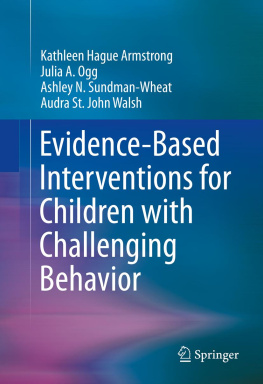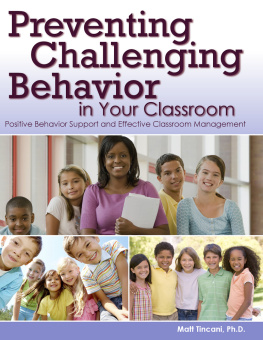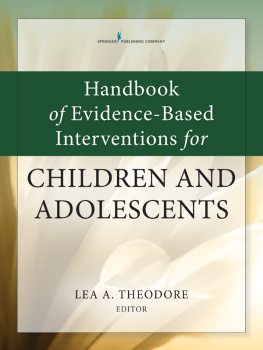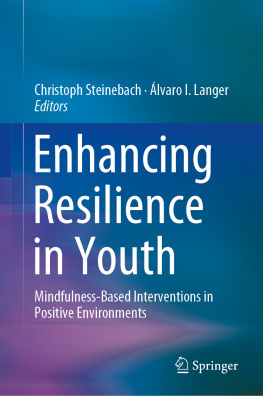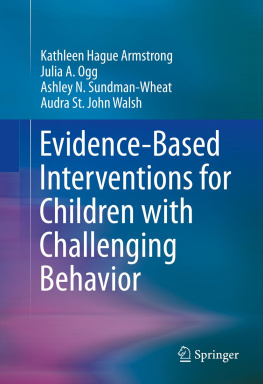Kathleen Hague Armstrong , Julia A. Ogg , Ashley N. Sundman-Wheat and Audra St. John Walsh Evidence-Based Interventions for Children with Challenging Behavior 2014 10.1007/978-1-4614-7807-2_1 Springer Science+Business Media New York 2014
1. Common Early Childhood Behavior Problems
Abstract
Challenging behavior in young children is common. It can be difficult for parents or early childhood professionals to know what behaviors fall within the typical range of behavior. This chapter outlines the prevalence of common behavioral concerns among young children (sleep problems, feeding issues, colic/excessive crying, toileting issues, fears/worries/anxiety, sexual behaviors, aggression, and social skills) and outlines guidelines for how to address these concerns. Strategies to ensure cultural competence in working with a diverse range of families are also outlined.
Behavior problems in young children are common (Williams, Klinepeber, & Palmes, ). Healthy toddlers are extremely active, restless, and impulsive, not because they have a disorder, but because they need to move about and experience to learn. Furthermore, each child comes with his or her own temperament, making for huge variations of personalities, even within families. Providing parents with basic parenting guidelines can help most families successfully navigate through the early childhood years. These strategies, such as developing and maintaining consistent routines, removing dangerous temptations, praising desired behavior, and redirecting problem behavior, are beneficial to all children.
Even so, approximately 20 % of US children have a diagnosable behavioral health disorder, and less than 20 % of those in need will receive help (Society for Research in Childrens Development, ). Thus, it becomes important to differentiate between behaviors that are normal and will possibly be outgrown and those needing more individualized attention.
It can be difficult to separate typical behaviors of early childhood from those that would be considered problematic. For example, problems such as sleep difficulties or short attention spans may be typical with young children, but those issues become more problematic as children get older. Research suggests that rather than just considering the behavior by itself, one might want to observe for patterns of behavior (Mathiesen & Sanson, ).
The next sections provide information on a number of common behavioral concerns in early childhood, including sleep problems, feeding issues, colic/excessive crying, toileting issues, fears/worries/anxiety, sexual behaviors, aggression, and social skills. These challenging behaviors were selected for discussion because (1) they are frequent concerns for young children and their families (prevalence rates for most is at least 20 %), (2) they are issues presented frequently in our clinical practice, and (3) these difficulties have been described by other authors as prevalent concerns in young children (e.g., Young, Davis, Schoen, & Parker, ). This overview is intended to help early childhood professionals know what behaviors can be expected during the typical course of development, and to be able to distinguish behaviors which may be indicative of more serious and chronic problems in need of more intensive intervention. Information about these common concerns as well as guidelines to promote healthy development are presented.
Sleep Problems
Prevalence
Sleep problems are one of the most commonly reported difficulties in young children, and may be associated with a variety of conditions and medical problems. Sleep is important for renewing mental and physical health, while sleep disorders can lead to reduced health and in some cases may be life threatening (Luginbuehl, Bradley-Klug, Ferron, Anderson, & Benbadis, ).
The most common sleep problems in young children are difficulty falling asleep, waking up during the night, or a combination of both (Lyons-Ruth, Zeanah, & Benoit, ). In addition, toddlers and preschool children may have difficulty with nightmares, night terrors, sleepwalking, and sleep talking (Armstrong, Kohler, & Lilly, 2009).
Guidelines
According to the National Sleep Foundation ( outlines the National Sleep Foundation Guidelines for the amount of sleep needed by children, and may be used to help parents begin to pinpoint sleep problems and take steps to improve sleep.
Table 1.1
National Sleep Foundation Guidelines for hours of sleep needed
Age | Hours of sleep |
|---|
Infants (311 months) | 912 h during the night + |
30 min to 2-h naps, 14 times a day |
Toddlers (13 years) | 1214 h |
Preschool (35 years) | 1113 h |
School-aged children (512 years) | 1011 h (children typically do not nap after 5 years) |
To address difficulty falling asleep, the first step is to alter the childs sleep habits, often referred to as sleep hygiene. Sleep hygiene includes strategies which can be used to solve sleep problems and begins with the establishment of a regular nighttime routine. Difficulty falling asleep can be a pattern of behavior which develops because the child has connected the action of falling to sleep with something else, generally related to the parent, such as rocking, being held, nursed, or some sort of motion, and cannot fall asleep by him or herself. To correct this sleep problem, parents have to reteach the child to fall asleep with a new set of associations, such as a blanket or stuffed animal. The process involves developing a relaxing bedtime routine, followed by gradual separation from the child beginning with 2 min intervals, and brief comforting to let child know he or she is safe. Parents will find this intervention difficult to follow because their child will protest, and will need encouragement to stay the course. Most children will learn to sleep on their own within 5 days of consistent teaching (Ferber, ).
Even when caregivers are attempting to set healthy routines, limit setting problems around bedtime generally begin around age 2, when toddlers are naturally testing limits, and resolve when parents develop consistent bedtime routines and remain firm in their expectations. Bedtime routines that help children sleep well include wind down activities such as a warm bath; avoidance of television or other media before bed; keeping bedrooms cool, dark, and distraction-free; and building in time for some personal interaction at bedtime, like reading books or saying prayers. Parents should also avoid giving their child food or drinks containing caffeine, or over-the-counter cough medications that contain stimulants.
To address the issue of young children staying asleep during the night, an initial consideration is nighttime feedings. Nighttime feeding problems are addressed by gradually reducing the habit of providing the child with food at night. By 6 months of age, a baby should be able to sleep through the night without feeding or feeling hungry (National Sleep Foundation, ). Nursing babies can wait to be fed in increasingly longer intervals, until nighttime feedings are eliminated. Bottle-fed babies are offered one ounce less at each feeding and at less frequent intervals during the night, until the problem is resolved. A protein snack shortly before bed for older children can help ease hunger until morning.

